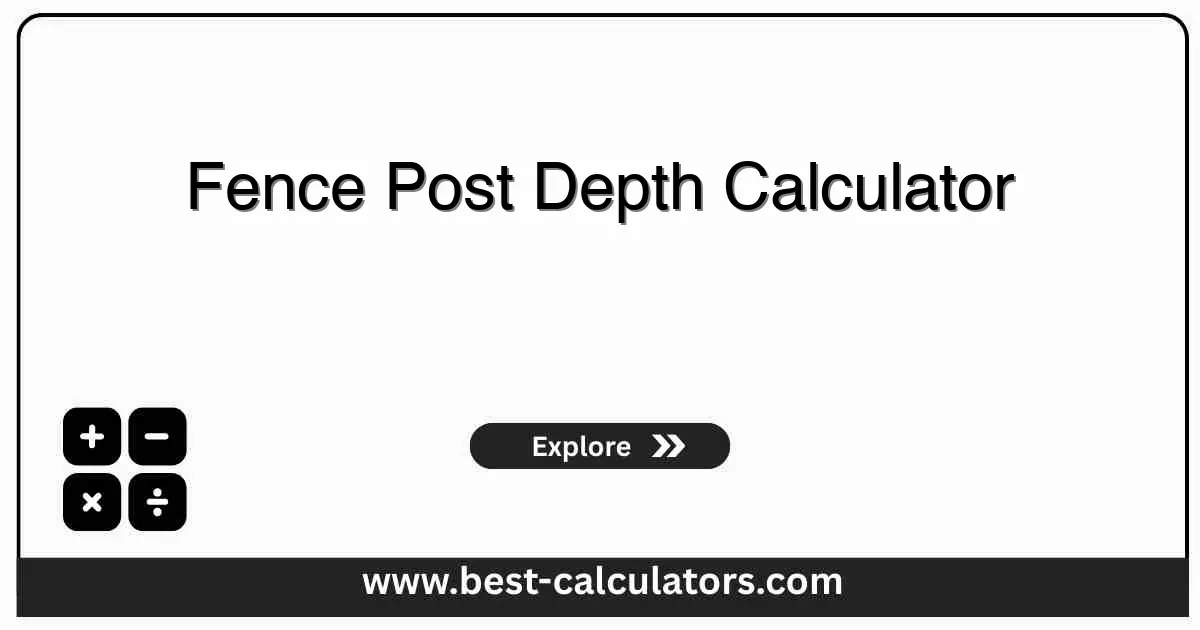Fence Post Depth Calculator - Calculate Minimum Hole Depth
Determine the mandatory depth for fence post holes to ensure structural stability against wind loads and prevent frost heave in cold climates.
Fence Details
Results
What is a Fence Post Depth Calculator?
A Fence Post Depth Calculator is a critical planning tool for anyone building a fence. It determines the minimum hole depth required to securely anchor a fence post, ensuring it can withstand strong wind loads without leaning and resist environmental forces like ground freezing (frost heave).
Correctly setting your posts is the single most important factor in the longevity of your fence. Shallow posts are the leading cause of fence failure, leading to leaning sections and expensive repairs. This calculator helps you get it right the first time.
This calculator evaluates:
- Structural Stability: The depth needed to support the height and weight of the fence.
- Frost Protection: The depth required to reach stable soil below the freezing line.
To estimate the total number of posts, rails, and pickets for your project, try our Fence Calculator.
For calculating the bags of concrete mix needed to set your posts, use our Concrete Calculator.
If you are building a deck instead of a fence, check out our Deck Footing Calculator for specific pier requirements.
For general digging volume and gravel base estimation, see our Gravel Calculator.
If you need to check property lines or plot sizes before digging, use the Acreage Calculator.
How It Works
The calculator applies two primary rules and selects the deeper (safer) option:
The logic is based on:
- The 1/3 Rule (or 1/2 Height): Structural engineers recommend that 1/3 of the total post length (or 1/2 of the exposed height) be buried underground for leverage against wind.
- The Frost Line Rule: To prevent the post from being pushed out of the ground by freezing soil, the footing must extend below the frost line depth specific to your region.
Key Concepts Explained
Frost Line
The depth to which groundwater in soil is expected to freeze. Posts not buried below this line will "heave" or pop up during winter.
Wind Load
The force wind exerts on the fence surface. Taller privacy fences act like sails and require deeper roots for leverage.
Gravel Base
A 6-inch layer of gravel at the bottom of the hole. Essential for drainage to prevent the wooden post bottom from rotting.
Bell Shape
Digging the hole wider at the bottom (bell shape) helps lock the concrete footing into the ground against frost uplift.
How to Use This Calculator
Enter Height
Input the intended height of the top of the fence above ground level (e.g., 6 ft).
Check Frost Line
Search online for your local frost line depth. If you live in a warm climate, you can enter 0.
Calculate
Click to see the minimum digging depth and the total length of the post you need to buy.
Add Gravel
Remember to dig 6 inches deeper than the result to accommodate the gravel drainage base.
Benefits of Proper Post Depth
- • Structural Integrity: Prevents the fence from leaning or blowing over during storms or high winds.
- • Long-Term Savings: Avoids the costly and labor-intensive process of digging up and replacing failed posts after a few years.
- • Winter Resilience: Stops the ground from spitting your posts out when it freezes, keeping your fence line straight.
- • Safety: Ensures the fence serves its purpose as a secure barrier for children and pets.
Factors Affecting Your Results
Soil Type
Loose, sandy soil has less holding power and may require deeper holes or wider concrete footings than dense clay soil.
Gate Posts
Gate posts endure dynamic stress from movement. Always dig these deeper and wider than standard line posts.
Local Building Codes
Your municipality may have strict codes that supersede general rules. Always call 811 before digging to check for utilities.

Frequently Asked Questions (FAQ)
Q: How deep should a fence post be?
A: A general rule of thumb is that the hole depth should be 1/3 to 1/2 of the total post length. For a standard 6-foot fence, this typically means burying about 2.5 to 3 feet of the post.
Q: Does the frost line matter for fence posts?
A: Yes, absolutely. In cold climates, the bottom of the post hole must extend below the frost line to prevent "frost heave," which can push the post up out of the ground as the soil freezes and thaws.
Q: How wide should the post hole be?
A: The diameter of the post hole should generally be 3 times the width of the post. For a standard 4x4 post (which is actually 3.5 inches wide), a 10-12 inch diameter hole is recommended.
Q: Should I put gravel at the bottom of the hole?
A: Yes, adding about 6 inches of gravel at the bottom of the hole before setting the post improves drainage and helps prevent the wood from rotting.
Q: Do gate posts need to be deeper?
A: Yes. Gate posts bear dynamic loads from the swinging gate. It is recommended to dig gate post holes at least 6-12 inches deeper and slightly wider than regular line posts.